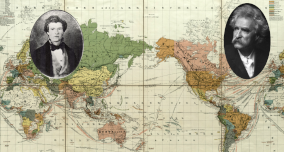February 15, 1896: At Siliguri...they changed to one of the canvas-covered, six-passenger cars which hugged the two-foot-gauge rails of the Darjeeling Himalayan Railway. For about seven miles they darted through rice fields and tea gardens to Sukna, where the 7,000 ascent began. The miniature train slowed to less than ten miles an hour as it passed through forest and wild botanical gardens, rounded countless goompties (zigzags), crept under cliffs, and edged along chasms. At 4864 feet they paused at Kurseong before climbing to Ghoom, the highest rail point (7407 feet), and dropping some hundreds of feet to the great ridge on which Darjeeling is scattered [“MT India” 88]. (Fears)
Richard Zacks, in Chasing the Last Laugh (page 255), provides an observation from a traveler to Darjeeling during the Raj: "One traveler said he arrived 'prepared for grand emotions' at seeing the awe-inspiring mountains but instead discovered he was in an English resort town, with posters hawking English amenities: Colman's mustard, Pears Soap, Beecham's Pills (laxative). He saw privileged English schoolchildren either on horseback or walking, always followed by a submissive Hindu servant ... with tennis courts available and English-style bungalows and creeping roses ... and an English stone clock tower ... and assembly rooms for dances, Protestant chapels, and pomaded hair. At the boarding house, he found politeness, piano, and Gilbert & Sullivan or patriotic songs. 'Of all races living abroad, the English adapt themselves the least to foreign cultures,' groused Andre' Chevrillon. 'They defy assimilation of any sort and re-create home while abroad.'"
